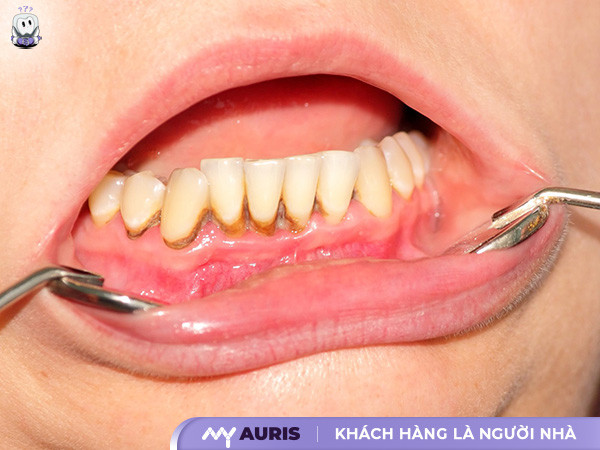To prevent tartar, dentists always recommend maintaining proper oral hygiene, including brushing, flossing, and rinsing with an antiseptic mouthwash. However, do you truly understand what tartar is? How does tartar form? And what consequences can arise if too much plaque accumulates on teeth and gums? In this article, My Auris Dental Clinic HCMC will help you learn in detail about tartar, its causes, its harmful effects on the oral cavity, as well as safe and effective methods for removing tartar.
What is Tartar?
Tartar, also known as dental calculus, is a layer of calcified dental plaque formed by minerals in saliva, appearing on or below the gum line. It is one of the main causes of gum problems and periodontitis.
Oral bacteria always exist in the oral cavity, even if you regularly practice oral hygiene. Bacteria combine with proteins and food debris, forming a sticky film that adheres tightly to the teeth – known as dental plaque. If not cleaned promptly, this plaque will harden, transforming into tartar, which cannot be removed by regular brushing.
Tartar contains many harmful bacteria, weakening tooth enamel, causing roughness, and damaging the gums. If not removed, tartar can lead to gum recession, increasing the risk of periodontitis, and even causing premature tooth loss.

Types of Tartar
Common Tartar
Common tartar appears around the neck of the tooth, exhibiting an opaque white or pale yellow color. For smokers, tartar can be darker. This type of tartar easily causes gingivitis, and if not removed promptly, it can lead to bleeding gums. Blood accumulating in the plaque can turn the tartar into serum tartar.
Serum Tartar
Serum tartar is located below the gum line and is reddish-brown or dark black in color. Compared to common tartar, this type contains more bacteria, easily causing gingivitis and increasing the risk of root infection, severely affecting dental health.
Tartar Classification by Degree
Grade 1 Tartar
This is the earliest stage, when tartar has just formed. The plaque is still thin, light in color, and usually appears along the gum line. Proper oral hygiene can reduce Grade 1 tartar, but it cannot be completely removed without a dental visit.
Grade 2 Tartar
At this stage, tartar has become thicker and firmly attached to the tooth surface. Although its color is still quite light, it cannot be removed by regular brushing. Specialized dental instruments are required for cleaning.
Grade 3 Tartar
Tartar at this grade is dark yellow, thick, and hard, often appearing on the inner surfaces of the teeth. If not treated promptly, the tartar will continue to grow and cause severe gingivitis. In some cases, Grade 3 tartar can spread to the outer surfaces of the teeth, affecting aesthetics.
Grade 4 Tartar
This is the most severe grade, where tartar turns dark brown or black, adheres firmly to the tooth roots, and poses a risk to the jawbone. If not treated early, accumulated bacteria can cause periodontitis, leading to loose teeth and even permanent tooth loss.

How does Tartar Form?
Everyone naturally has oral bacteria. When consuming sugary and starchy foods, if oral hygiene is not maintained properly, bacteria will thrive, forming plaque on the tooth surface. These bacteria produce acids, eroding tooth enamel, and combining with proteins and minerals from saliva, gradually forming dental calculus, also known as tartar.
Tartar is an accumulation of dead, mineralized bacteria, along with components from saliva and food. The main components of dental calculus include: Calcium phosphate, Calcium carbonate, and Magnesium phosphate.
If not removed promptly, plaque will absorb more minerals, gradually harden, change color, and adhere firmly to the teeth. Over time, tartar becomes thicker and harder, causing aesthetic issues and posing potential risks of gingivitis and tooth decay.
Causes of Tartar Formation
Tartar primarily forms due to the accumulation of dental plaque that is not properly removed. When eating, especially foods high in sugar, bacteria in the mouth use sugar to grow, forming a layer of plaque on the tooth surface. If oral hygiene is not maintained regularly, the combination of food, saliva, and bacteria will gradually harden, turning into tartar that firmly adheres to the teeth.
This condition often occurs when proper oral hygiene habits are not maintained, increasing the risk of tartar formation. Therefore, brushing correctly and regular dental check-ups are effective solutions to protect oral health and prevent tartar accumulation.

Harmful Effects of Tartar on Oral Health
Tartar is stubborn plaque that forms on the tooth surface and gum line, which cannot be completely removed by brushing or flossing alone. If not properly cleaned, tartar provides an ideal environment for bacteria to grow, leading to tooth decay, bad breath, and other dangerous oral diseases.
Over time, prolonged tartar accumulation can lead to gingivitis, the initial sign of dental diseases. If left untreated, gingivitis can progress to periodontitis, damaging the bone and supporting tissues of the teeth. In severe cases, teeth may become loose and completely lost.
Not only harmful to oral health, tartar can also negatively impact cardiovascular health. When bacteria from tartar enter the bloodstream, they can stimulate systemic inflammatory responses, increasing the risk of cardiovascular disease and various other health problems.
How to Detect Tartar Accumulation?
Tartar typically adheres to the tooth surface and is yellow or brown in color. It is a layer of calcified dental plaque that can cause various oral hygiene issues. During routine dental check-ups, dental professionals will detect and proceed to clean the teeth to remove tartar.
You can check for dental plaque yourself by using plaque-disclosing tablets – a product readily available at pharmacies without a prescription. This product helps identify remaining plaque areas by temporarily staining them, assisting you in adjusting your oral care routine more effectively.
Effective Ways to Prevent Tartar
Tartar not only causes aesthetic issues but also leads to tooth decay, gum disease, and many other oral health problems. Therefore, preventing tartar early on is crucial. Below are effective ways to maintain oral hygiene, reduce plaque, and best protect tooth enamel.
Brush correctly and regularly: Brush your teeth 2 – 3 times/day with a soft-bristled toothbrush and fluoride toothpaste. Use products from reputable brands with quality certification. Replace your toothbrush every 3 months or when the bristles are worn.
Use dental floss to remove food debris: Dental floss helps clean between teeth where a toothbrush cannot reach. Do this twice a day, and you can combine it with interdental brushes for increased effectiveness. If you are new to it, ask your dentist for proper usage instructions.
Use antiseptic mouthwash: Choose an alcohol-free mouthwash that kills plaque-causing bacteria. Rinse twice a day after brushing to enhance tooth enamel protection.
Limit smoking: Smoking increases the risk of tartar formation and causes tooth discoloration. Smokers generally have a higher risk of gum disease compared to non-smokers.
Regular dental check-ups: Visit the dentist twice a year for professional cleaning and examination. If tartar accumulation is significant, more frequent scaling may be necessary.
Maintain a scientific diet: Oral bacteria thrive on sugary and starchy foods. Limit sweets and snacks; instead, eat plenty of green vegetables, fruits, and drink plenty of water.
Use tartar-control toothpaste: Choose fluoride toothpaste, which helps remineralize enamel and prevent tooth decay. Some products contain triclosan, which works against plaque-causing bacteria.

When to See a Dentist for Tartar Buildup?
The frequency of tartar removal depends on the rate of plaque and tartar accumulation for each individual. Typically, experts recommend visiting a dentist for a check-up and tartar cleaning every 6 months. However, if you experience tooth decay, gum disease, or signs of infection, you should visit the dental clinic immediately for examination and timely treatment.
If you are looking for a reputable address for tartar removal, visit My Auris Dental Clinic immediately. With a team of experienced doctors and modern dental equipment, My Auris is committed to providing a quality dental examination and care experience, helping patients quickly remove tartar and optimally protect their oral health.
Tartar cannot be removed by ordinary oral hygiene practices. Once formed, only a dentist can effectively clean it. Therefore, don’t forget to get regular tartar removal and maintain proper oral care to prevent plaque, tooth decay, gum disease, as well as other serious health problems.





